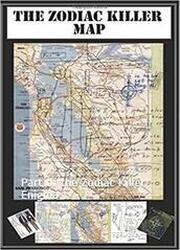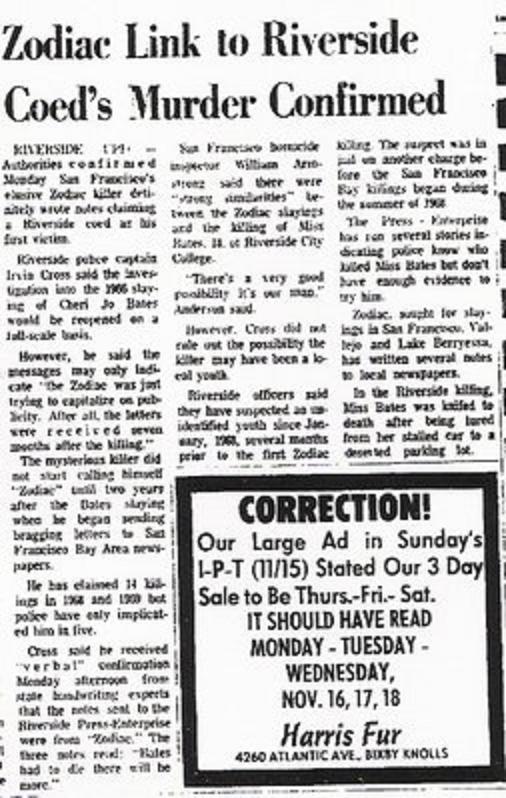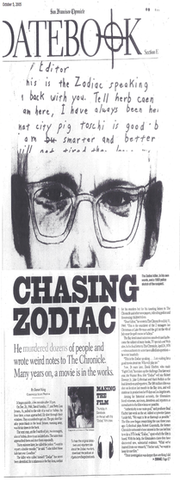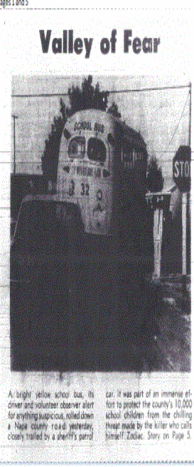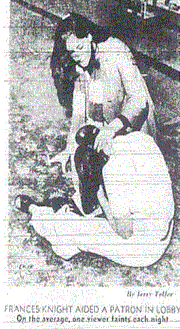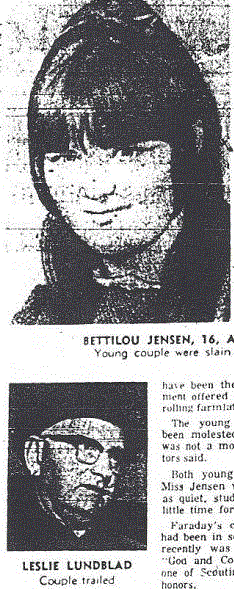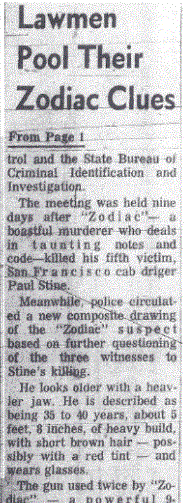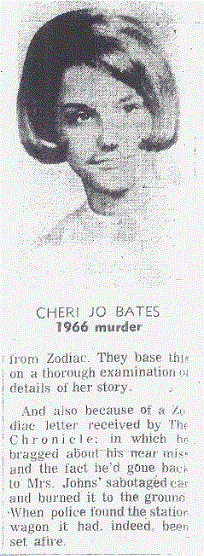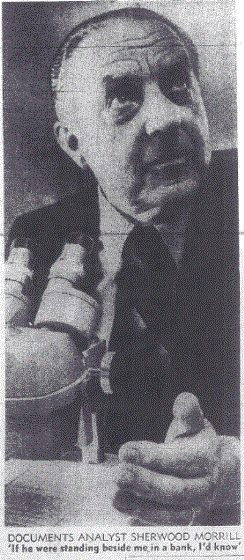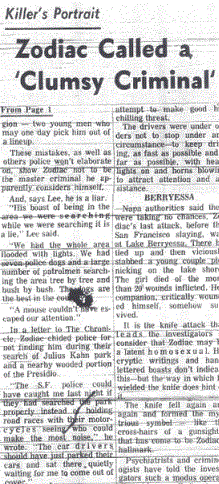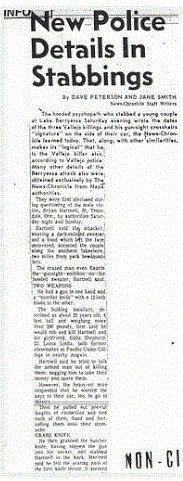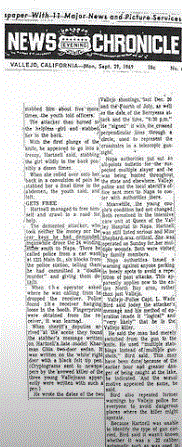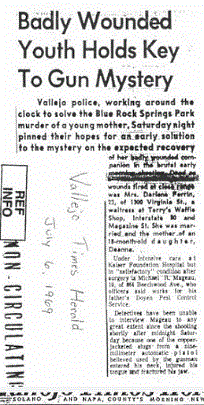When determining whether the author of the Confession letter mailed on November 29th 1966 was the killer, little attention is paid to the autopsy report. Although the basics of the attack on Cheri Jo Bates was covered in the newspapers such as "stabbed in the back, arms and face, and her throat slashed" (which is only partially accurate), is there anything else in the autopsy report that could lend weight to the murderer and author being the same person. The retelling of the attack on Cheri Jo Bates over the last 53 years has for a large part been totally inaccurate, with the notion of an organized and experienced knife attack, and Cheri Jo Bates receiving 40+ stab wounds and nearly decapitated, totally unsubstantiated by the autopsy report of Surgeon F. Rene Modglin (46). The autopsy report paints a totally different picture. In the last article the complete findings of the autopsy report was written in text form, to provide an easily readable reference point and allow people to 'cut and paste' any details that they require. If we are to determine whether the author of the Confession letter was the killer, then we have to examine its contents in relation to publicly unreleased details contained within the autopsy report. Here is a basic overview of the wounds inflicted on Cheri Jo Bates in picture form, however, to understand the entire autopsy report, open the last article in a new tab for quick and easy reference.
[10] A 1.4 cm fresh vertical gaping sharp edge laceration in the upper medial quadrant of the left breast in the second ICB (Intercostal block).
[11] A 1.9 cm gaping sharp edge fresh laceration of the lower medial quadrant of the right breast in the third inner space.
[12] A 1.7 cm mainly transverse fresh laceration of the skin of the left chest over the 5th rib and centered about 2 cm medial to the left vertical nipple line.
Was this indicative of a killer primarily targeting the sexual organs of Cheri Jo Bates, or quite possibly targeting the heart for a fatal strike? Surgeon F. Rene Modglin described no substantive damage to any of the major or minor organs below the neck line, only "two moderately superficial lacerations in the anterior and medial of the left lung". This lies in close proximity to the heart, nestled near the midline of the chest cavity. The two strikes to the left breast undoubtedly responsible for the superficial damage to the anterior of the left lobe of the lung. It is these wounds that likely gave F. Rene Modglin the estimate for the minimum knife length, based on the entry point on the breast, along with the depth of the left lung and angle of the wound. He estimated "the minimum instrument dimensions for the knife blade would be half inch wide and three and a half inches long". However, this is only a minimum estimate, so the knife could have been a lot longer - further backed up by his comments at the end of the autopsy, where he added "There were no tell tale marks to indicate it had been plunged in up to the hilt". If no hilt marks could be observed, there is no way to fully determine the length of the knife and hence why F. Rene Modglin only gave a minimum estimate.
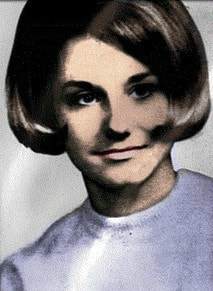 Cheri Jo Bates
Cheri Jo Bates The Confession letter continued, claiming "She let out a scream once and I kicked her in the head to shut her up. I plunged the knife into her and it broke. I then finished the job out cutting her throat". The only wounds to partly corroborate that the killer "kicked her in the head" was entry number two and three in the autopsy report.
[2] A 2 cm oblique ragged edge fresh non gaping laceration of the upper lip on the left side, that angles laterally from above and extends completely through the thickness of the lip. The teeth behind are not loose or broken.
[3] A dark blue-gray slightly swollen discoloration of mainly the mucocutanous portions of the upper and lower lips of the right side, involving a 2 cm greatest diameter.
This 2 cm ragged edge laceration (as described in the last article) is indicative of blunt force trauma compressing or shearing the lip either from an object, fist or possibly a foot. This could have been a glancing blow across her face because the autopsy report described no broken or loose teeth. Although this doesn't necessarily preclude a direct impact to the lip or mouth. The Confession letter author was effectively concluding his attack on Cheri Jo Bates when he stated "I plunged the knife into her and it broke. I then finished the job out cutting her throat". This may have been partially truthful, in that a knife with a hinge mechanism could have collapsed, causing him to end the attack and primarily use the knife as a slashing instrument on her throat to "finish the job out". There was only one wound to Cheri Jo Bates' back, so it isn't difficult to conclude that this strike was delivered when she was lying face down in the alleyway (and the position her body was ultimately found by investigators). This wound is described in the autopsy report.
[26] A 1.5 cm laceration in the skin of the back on the left side that is fresh, has sharp edge and gape. It is horizontally orientated and its medial and is about 2 cm lateral to the midline and opposite the spinous process of T7 (7th thoracic vertebrae found in the middle of the chest).
Skeletal and Muscular Systems: There is a 1.5 cm oblique cut in the bony portion of the 5th rib anteriorly on the left corresponding somewhat to the skin lacerations over it. There are no other bony lesions - and fractures are looked for. The lacerations of skeletal and muscle have been mentioned under specific areas.

Apart from a 4 cm gaping laceration to Cheri Jo Bates' right upper arm and "two somewhat abraded" lacerations to her left forearm, every single laceration described in the autopsy is 2 cm or less, indicating that the knife didn't necessarily enter and exit the body on a linear trajectory (because of Cheri's dynamic struggle for life). But the size of the wounds are consistent with a half-inch blade: 1.5 cm = 0.59 inches). The vast majority of the wounds were to the hands, fingers, neck and face. It could be suggestive of a killer who began his assault striking at her breasts or heart, before switching focus to her head region, and culminating the attack by inflicting multiple lacerations to her neck region which resulted in the severing of her right carotid artery and both superficial jugular veins.
[8] The anterior neck skin extensively and irregularly lacerated with marked gaping. A deep cut in the thyroid cartilage on both sides and the right common carotid is completely transected as well as the right superficial jugular vein.
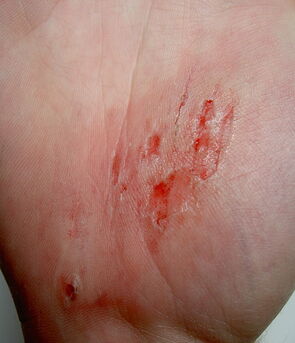
[6] An area of dark blue-gray discoloration of the skin of the left cheek and chin involving mainly the anterior two of the lacerations just mentioned. It is also criss-crossed by a few fine linear abrasions.
Entry [4] described numerous petechia in the skin of the forehead. These can be caused by manual compression, asphyxiation or strangulation, causing small blood vessels to burst into the skin. Petechiae may be seen on the face (including forehead) and in the whites of the eyes or on the inside of the eyelids.
Petechiae are the small pinpoint collection of blood lying in the skin, the sclera or the conjunctivae and under thoracic serous membranes. They vary in size from tenth of a millimetre to about two millimetres. The petechiae are caused by acute rise in venous pressure that in turn causes over distension and rupture of thin walled peripheral venules, especially in lax tissues, such as the eyelid, and in unsupported serous membranes, such as the visceral pleura and epicardium. This mechanism of raised venous pressure may be supported by the fact that they are rarely found in the victims dying of obstruction to air passages by means other than compression of neck, or from breathing some inert gas. Thus, petechiae are seen most often in the face and eyes of victims of compression of the neck (hanging/ strangulation) or fixation of the chest (traumatic asphyxia).
Link.
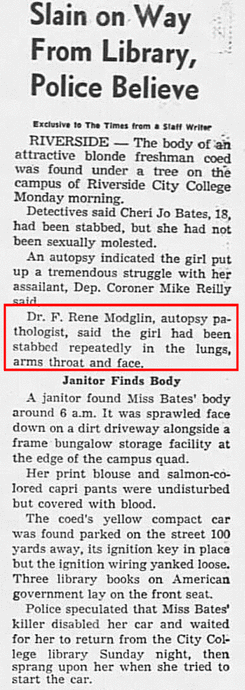
In summary, we have twenty-six entries in the autopsy report and not one single organ below the neck line received any fatal damage, other than the two superficial marks received by the anterior and medial of the left lung. This is not indicative of somebody who was able to dominate and overpower the young woman, who protected herself the majority of the time with her hands and arms but for the three wounds to her breasts and nothing below the wound of her right breast in the abdominal region. This is not to say it wasn't a vicious and cruel murder, which it undoubtedly was.
We also cannot determine with any great confidence that the Confession letter was the killer, unless we can inextricably bind the "kick to the head" to the lip damage, or the knife breaking to the wound by T7 or the back during the latter stages of the attack. Whatever the case, the desperate search for her killer or killers rages on.
THE CHERI JO BATES AUTOPSY FINDINGS - PART ONE
THE CHERI JO BATES AUTOPSY FINDINGS - PART THREE
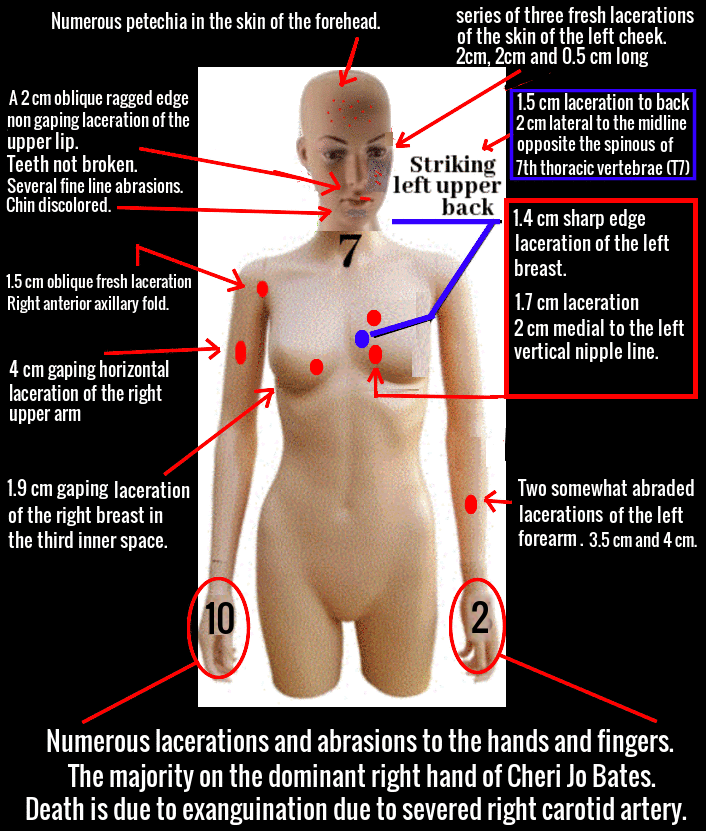
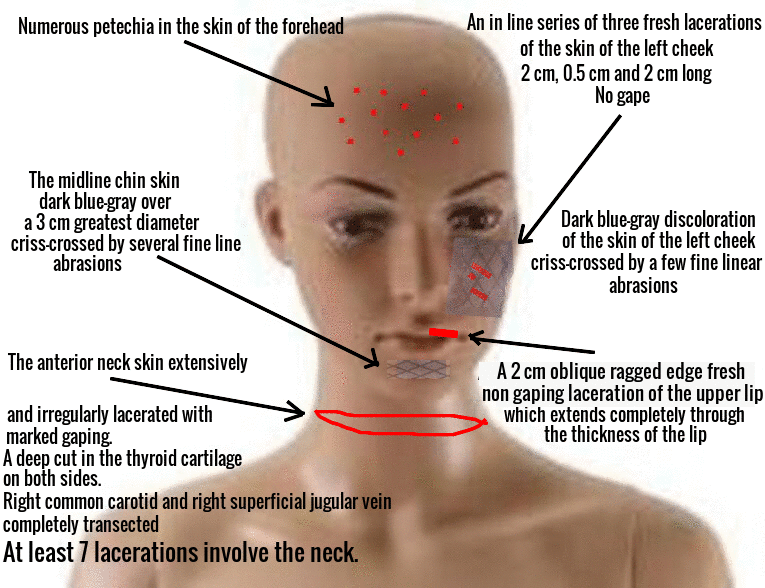




 RSS Feed
RSS Feed




